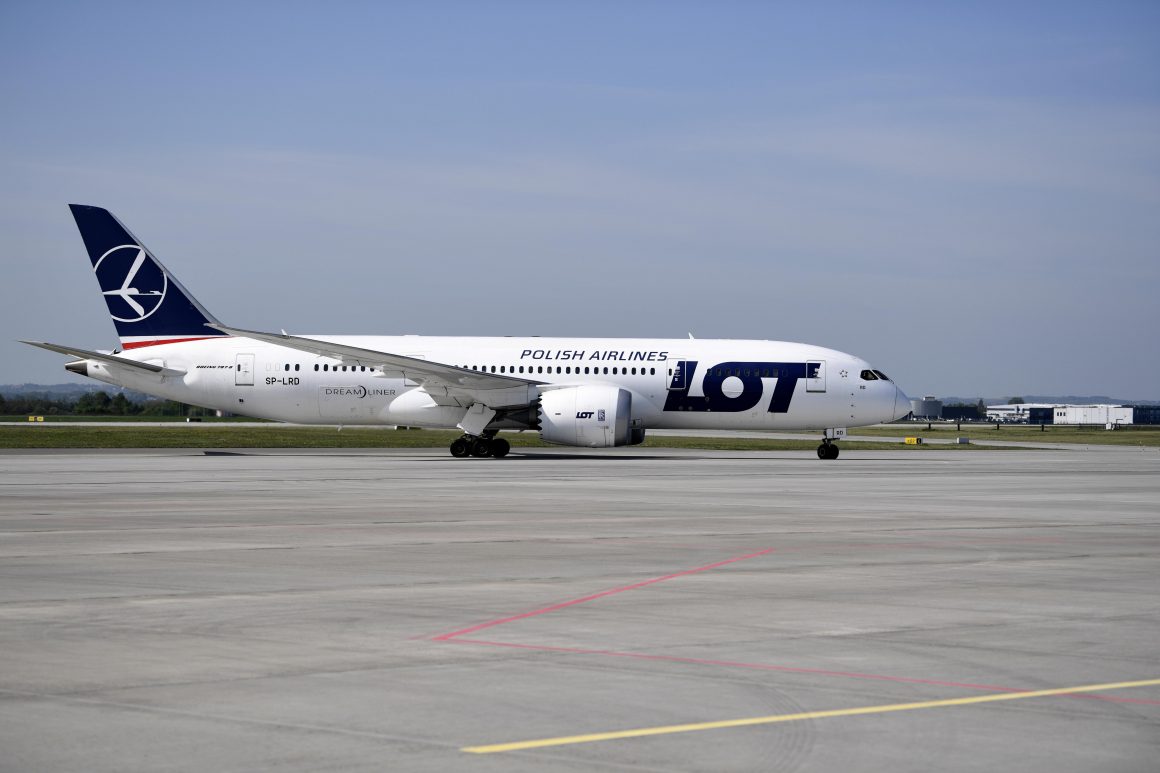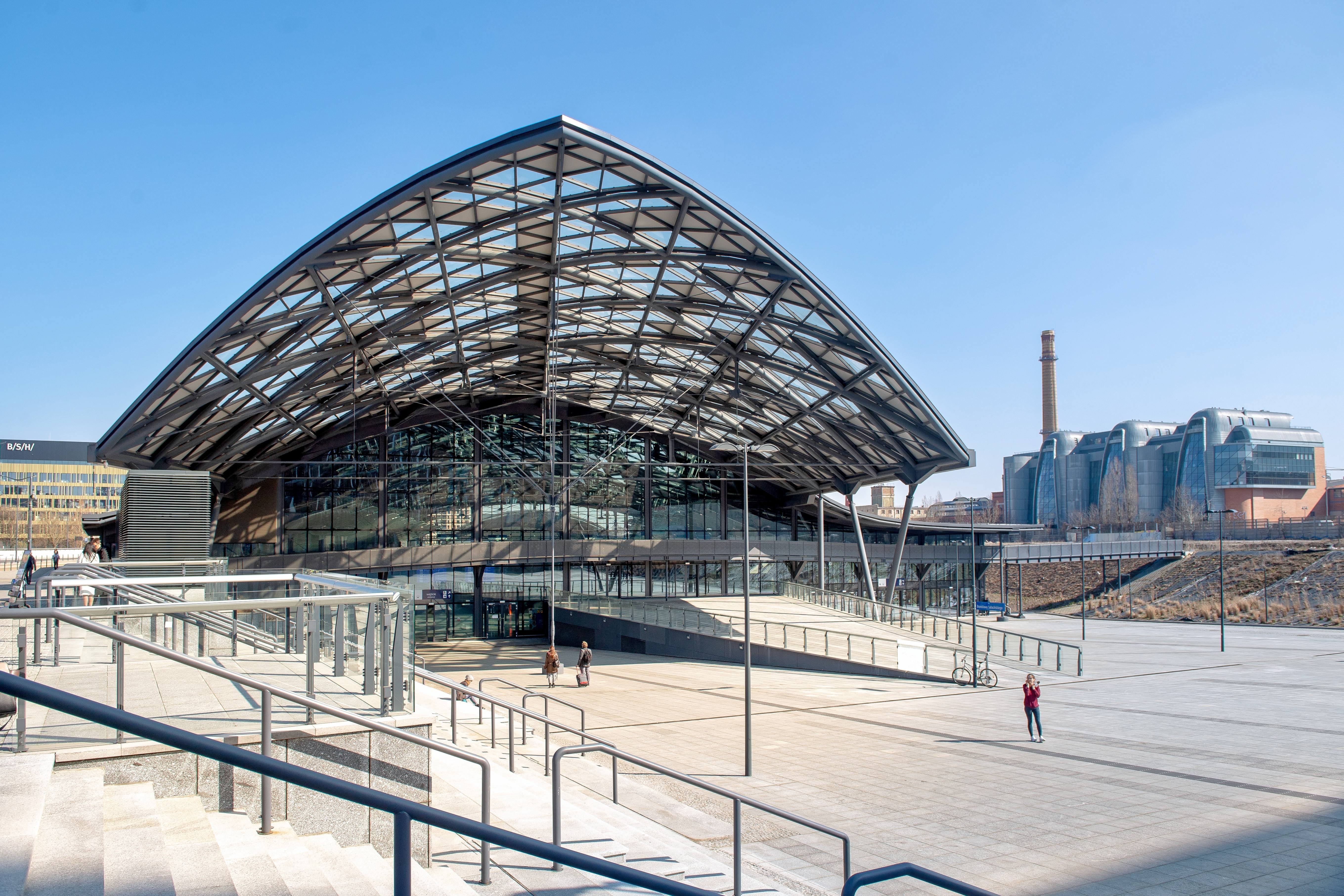THE WARSAW INSTITUTE REVIEW
Date: 5 July 2019 Author: Mikołaj Wild
Solidarity Transport Hub. Poland’s Much Needed and Economically Viable Infrastructure Investment
Central Eastern Europe is a region that offers promise of tremendous growth in air traffic. Economic forecasts indicate a high profitability of a new airport to be located between Warsaw and Łódź. Thoughtfully governed states tend to invest into large scale airport infrastructure. It is high time for Poland to join their ranks
 JASIONKA AIRPORT, APRIL 30, 2018. BOEING 787 DREAMLINER. © DAREK DELMANOWICZ (PAP)
JASIONKA AIRPORT, APRIL 30, 2018. BOEING 787 DREAMLINER. © DAREK DELMANOWICZ (PAP)Two parallel runways, each 4000 metersin length, will allow for serving 45 million passengersper year, with and two further runwaysto be constructed in later stages, along with taxiways, aprons, terminals: passengers, cargo, general aviation, and a railway stationintegrated with the passenger terminal. The initial concept of the Solidarity Transport Hub Poland (STH), to be located 37 kilometers from Warsaw,will be presented to airline executives from all around the world in July this year.
One cannot design a well-thought-out airport without first consulting those who will be its primary users – the airlines. As such, the Airport Consultative Committee (ACC)has been established by the International Air Transport Association (IATA), in cooperation with STH. The consultative committee is composed of representatives of all the airlines that are currently operating out of Chopin Airport, as well as those airlines that are not currently associated with Chopin but are prospective stakeholders for Solidarity Transport Hub Poland. The goal of ACC is to develop and consult the concept behind STH in cooperation with the airlines, in order to better understand their needs, and if necessary, adjust the project to better cater to their expectations.
Why is Solidarity Airport needed?
Before all else, rationale for the investment is based upon a real and actual market demand. Polish airports served more than 46 million passengerslast year, a 15% year to year increase, and a fivefold increase compared to fifteen years ago (8.8 million in 2004).Projected figures for 2019 indicate a further increaseof over 10% as compared with 2018, which means that Polish airports will serve over 50 million peoplethis year.
But there is more. In Poland the mobility coefficient(number of air travels per capita) is just above 1, while in Western European countries amounts to anywhere between 2 and 4. Therefore, there is a massive potential for improvement. Central and Eastern Europe experiences a consistent increase in air travel per capita – which is a product of continuous efforts aimed at closing the civilizational and economic gap resulting from the years of communism.
Moreover, Chopin Airport– the largest airport in Poland – with its 40% shareof the total passenger traffic in Poland, isnearing itsmaximum capacity. The seasonal daily limit of operations has been reached already and carriers looking to expand are faced with severe limitations of airport slots available (landing and take-off permits). The unfortunate reality is that Chopin airport has no space to expand further, which is due to both environmental and infrastructural constraints, related to continuous urban sprawl around the airport, and therefore noise reduction requirements, as well as roads traversing in direct vicinity of the airport, all of which preclude construction of additional runways.
Polish national carrier, LOT Polish Airlines, is also the main operator flying out of Chopin Airport with 70% flightsarriving and departing from this largest Polish airport. The Polish carrier is also the largest airline in the CEE region. As of today, between the Baltic, Adriatic and Black seas, inhabited by a total of over 180 million people,there are no – other than Chopin Airport and LOT – airport-airline tandem ready for developing an airport hub. Importantly,LOT is the last airline based in former communist states that has not gone bankrupt, has not been acquired by a third party – but instead is noting consistent growth, bringing in revenue streamsto the national treasury.
Chopin Airport is recording consistent growth rates of well over 10% annually. According to Polityka Insight, even if all of the currently ongoing investments at the Chopin Airport were to be finalized, and Modlin and Radom airports enlarged, these three airports in Central Poland will reach their maximum capacity anytime between 2022 and 2025. Here, stakes are high; overcrowded Chopin airport and an inability to satisfy market demands could negatively affect Poland’s prospect of economic growth.
4.3 billion peopletravelled on commercial airliners in 2018 globally. As per IATA, this number will increase to 4.6 billion passengersthis year and double within the next 20 years, thus exceeding 8 billion. According to Eurocontrol forecasts, because of insufficient capacity of the currently existing airports as well as limited airspace in 2040 Europe’spotential 160 million passengerswill not be able to engage in air travel. Vice Chairman of IATA Rafael Schvartzmanhas stated that Europe needs new airport infrastructure, and Solidarity Transport Hub is one of the solutions to the problem.
 ŁÓDŹ, MARCH 23, 2019. MULTIMODAL BUILDING OF THE ŁÓDŹ FABRYCZNA RAILWAY STATION. © GRZEGORZ MICHAŁOWSKI (PAP)
ŁÓDŹ, MARCH 23, 2019. MULTIMODAL BUILDING OF THE ŁÓDŹ FABRYCZNA RAILWAY STATION. © GRZEGORZ MICHAŁOWSKI (PAP)Hub airport and its impact on the economy
Third, the airport component is bound to yield profit. Multiple examples point to cargo hubs being a major stimulus for the economy. Air transport, both passenger and cargo – is concentrated in large hubs, with cities and states hosting them benefiting greatly in economic, social and political terms. The relationship is fairly straight forward: connectivityis a key to commercial success; being located along a frequently used trade route provides immeasurable benefits, which can be tapped into by a well-designed transport hub.
E&Y led MEO Principle Teststhat have focused on the profitability of the airportcomponent indicate that STH’s return on investmentis likely to exceed 10%. Furthermore, according to Baker McKenzie and Polityka Insight analysts, STH Poland could help garner an additional 4–7 GDP percentage pointsfor the Polish economy. Experts claims, that by virtue of its geographic location, Poland could potentially absorb a significant percentage of air traffic between Europe, North America and Asia. In addition to that, the investment is likely to create additional 150 thousand new workplacesin and around STH and related industries.
According to the aforementioned report, aviation is one of the most productive sectors of the Polish economy. Eurostat data indicate, that there are over 1000 commercial entitiescurrently involved in aviation market in Poland. Those companies employ a total of over 40.000 people; and taken together are responsible for creating a net value of over PLN 7.1 billion. In other words, a single employee contributes six times more to the economy as compared to the national average.
Good financial results of LOT, which as a national carrier has recorded from 2015 to 2018 a more than twofold increase of passengers(from 4 to 9 million), increased number of connections from 40 to 110 anddoubled its revenue(from PLN 3 billion to PLN 6 billion), recording a significant profit. Without the new airport however, LOT will not be able to retain this dynamic.
According to Baker McKenzie, the stretch of land from Scandinavia, through Poland to Greece remains outside of “the sphere of influence” of any and all major European airlines. Currently, those companies consider the region to be a source of passengers that are transferred to Western European, Russian, Turkish, or Middle Eastern hub airports, and who then switch to long distance flights. Consequently, 90% of long-distance flightsto and from CEE region occurs in hub airports far removed from the region, stripping Central and Eastern Europe from revenue streams.
Why a hub airport and a ‘hub and spoke model’? The essence of a hub and spoke model is for a flagship airline to develop connections to as many destinations as possiblefrom the airport that is simultaneously a base of operations for the airline. Looking at the connection network, flights converge on the central airport very much like wheel spokesare. By utilizing short and mid haul flights the carrier transfers passengers to the hub airport, from which the passengers can next conveniently transfer to either short, mid and long-haul flights (with the lattermost option taking place on wide body aircraft characterized by greater profit margins).
We know for a fact that passengers will be interested in flying to and out of Warsaw. Even today, half of LOT passengers use Chopin airport as a hub – in that they are flying neither to nor from Warsaw, but simply transfer there to another flight. Furthermore, the more affluent the societies of Central and Eastern Europe become, the more they will be willing to use airplanes as means of transportation. There is a scientifically proven correlation between an increase in GDP per capita and increase in air travel, which surely will translate to demand from passengers.
Railway component – an integral part of STH
Corresponding with airport development, railway infrastructure investments will too form a backbone of STH project. According to a government schedule and an agreement between STH and PKP PLK (Polish Railway Lines Authority), around 1.6 thousand kilometers of new railwayswill be built alongside the transport hub.Current plans assume that with completion of the so-called zero stagea 140 kilometer stretch of high-speed railwill be built, effectively creating a new HSR connection between Warsaw, STH and Łódź. This new line will allow for a 15-minute Warsaw-STHtransit time, and25-minute STH-Łódźtransit time.
The railway component of Solidarity Transport Hub will assume a “spider’s web” shape, with ten new lines radiating from STH. As a result, practically every major city in Poland will enjoy a direct connection to STH, with transit times of under 2.5 hours. In addition to that, regions bordering Czechia, Slovakia, Ukraine, Belarus, Lithuania and Kaliningrad Oblastwill too gain a convenient and fast access to STH.
Implementing the network-based railway system is an element of paramount importance for the overall success of the project. This is because at the present time, there are over 100 cities in Polandwith a population of over 10.000 inhabitants, that do not have a direct access to the railway network. For comparison sake: there is one such city in Czechia, eight in Slovakia, six in Hungary, and five in Austria. Painful as it may be this sad state of affairs is a historical result of partitions of Poland, a fact that becomes abundantly clear is one looks at railway connection density in eastern Poland, and the fact that a number of cities are missing a direct rail connection with Warsaw. This is because under partitions some cities were located in different states, which did not have an incentive to increase connectivity with Warsaw and sought to develop railway connections to their own respective capitals.
Planned investments in rail infrastructure will help Poland develop a more sustainable transport system. For years road transport has been prioritized in Poland. Unquestionably, the extend and pace of modernization of road networks is one of the staples of Poland’s economic and social development. Regrettably, this progress is not matched by railway infrastructure. While there were over 4000 kilometers of new highwaysbuilt since 1989, mere 50 kilometers of railway lineshave been built in the same period. STH program presents an opportunity to make right on this failure, as the railway infrastructure investments partial to STH program will allow for more optimized usage of already existing infrastructure.
Now or never
In conclusion, successful implementation of Solidarity Transport Hub Poland program will spur development and growth in Poland, as well as Central and Eastern Europe, exponentially increase passenger and cargo volumes, and place Poland firmly on major trade routes. I therefore urge all stakeholders not to consider STH through the prism of political rivalries and petty squabbles. STH is a unique development opportunity for Poland, which once realized will allow our country to leap forward in social, economic and civilizational terms.
As noted by PwC, projects that involve building or expanding airport infrastructure witha capacity exceeding 40 million passengers per annumare already underway in other European states, including Turkey, Russia and Germany. Construction of airportsin Moscow and Istanbulgoes hand in hand with a further expansion of their respective national airlines,that extensively utilize above mentioned hub airports to transfer passengers – a strategy that will likely be a success factor for STH. Solidarity Airport similarly to Moscow and Munichairports that are currently being expanded, will aim to satisfy the incessantly increasing demand for interchange traffic.
The decision to create a new hub airport in central Poland is long overdue. The idea was first conceived in the 70’s, while scores of studies, analyses and reports that documented the need for such investment have been published since early 2000’s, under auspices of different political parties. Today, Poland as an economic powerhouse of the Central and Eastern Europe has all the prerequisites needed to successfully develop a new transport hub, which is should be considered as must-have, bearing in mind that the entire region is in desperate need for additional airport capacity. By locating the new airport in a direct vicinity of two intersecting major international highwaysas well as train corridorsand integrating the airport seamlessly with railway and road systems and further investments, such as Airport City, it is safe to say there has never been a better time and place to build STH.
All texts published by the Warsaw Institute Foundation may be disseminated on the condition that their origin is credited. Images may not be used without permission.














